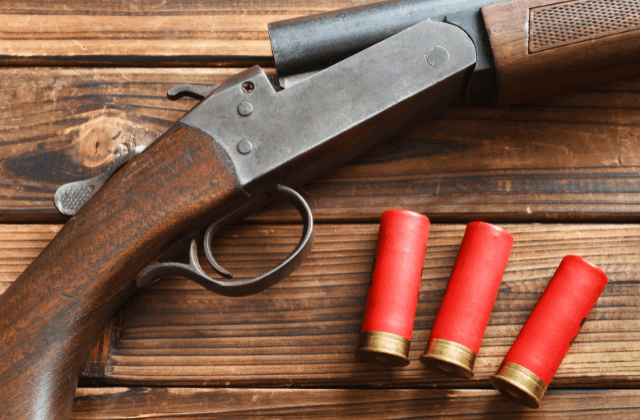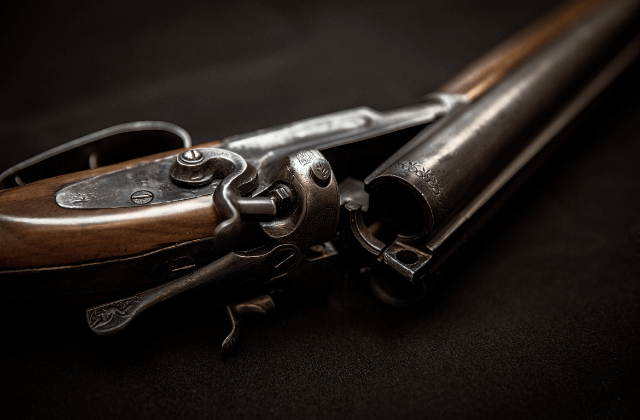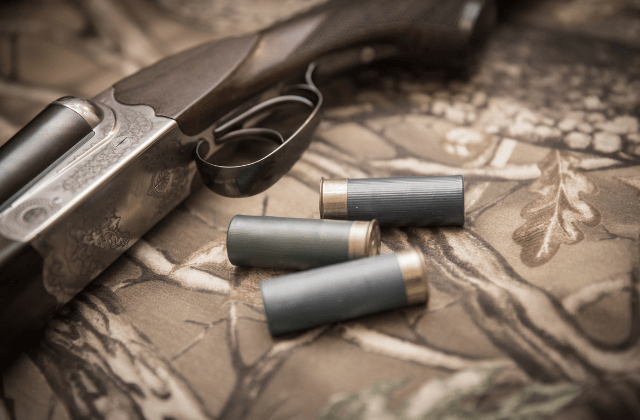This site contains affiliate links. As an Amazon Associate, I earn a commission from qualifying purchases at no extra cost to you. Full Disclosure Here.
Sawed-off shotguns are among the most notorious firearms in popular culture and have been the subject of fascination and controversy for decades.
However, in reality, sawed-off shotguns are illegal in many countries and heavily regulated in others. Because they have a shorter barrel, sawed-off shotguns produce a wider spread of shot, making them particularly lethal at close range, and their compact size makes them easier to conceal.
In this blog post, we will explore why sawed-off shotguns are illegal, the laws and regulations surrounding them, and the rationale behind these restrictions.
Why Are Sawed-Off Shotguns Illegal?
Sawed-off shotguns are typically illegal because they are classified as prohibited weapons in many countries. A sawed-off shotgun is a shotgun that has had its barrel shortened, either by sawing it off or by having a shortened barrel installed, which reduces the overall length of the firearm.

Some consider sawed-off shotguns to be particularly dangerous because they have a high potential for producing lethal injuries at close range due to their wide spread of pellets.
In addition, their short length makes them easier to hide or conceal, which allegedly makes them more attractive to criminals who intend to use them for illegal activities such as armed robbery or assault.
In the United States, the National Firearms Act of 1934 (NFA) regulates the possession, sale, and transfer of certain types of firearms, including sawed-off shotguns. Under the NFA, a shotgun with a barrel length of less than 18 inches or an overall length of less than 26 inches is considered a “short-barreled shotgun.”
To own a short-barreled shotgun, a person must register the firearm with the ATF and pay a tax stamp to legally possess a short-barreled shotgun. The registration process involves submitting fingerprints, photographs, and other identifying information to the ATF, as well as obtaining the signature of a chief law enforcement officer in the applicant’s area.
This process is designed to help prevent the possession of these weapons by individuals who may pose a threat to public safety.
Additionally, some states and municipalities have their own laws that further restrict or prohibit the possession of sawed-off shotguns altogether.
For example, in California, it is illegal to possess a sawed-off shotgun or any other firearm with a barrel length of less than 18 inches, except in limited circumstances such as those involving law enforcement or military personnel.
Other states, such as New York and New Jersey, also have strict regulations on the possession of sawed-off shotguns.
Overall, the restrictions on sawed-off shotguns are part of a broader effort to control the availability of firearms that are particularly dangerous or easily concealable and to prevent their use in criminal activity.
Check out Marine Approved article on Rifle Vs. Shotgun.
Legal Difficulties with Sawed-Off Shotguns
In the United States, sawed-off shotguns are regulated under the National Firearms Act of 1934 (NFA), which requires their registration and payment of a tax.
Regulation of Sawed-Off Shotguns
As mentioned, sawed-off shotguns are regulated under the NFA, which was enacted in response to the widespread use of machine guns and other dangerous weapons by criminals during the Prohibition era.

The NFA imposes strict regulations on the sale, transfer, and possession of certain types of firearms, including sawed-off shotguns.
Under the NFA, any shotgun with a barrel length of less than 18 inches or an overall length of less than 26 inches is classified as a “short-barreled shotgun” and is subject to strict regulations. We’ll talk about how one may legally possess a sawed off shotgun in a moment.
In addition to federal regulations, many states and municipalities have their own laws that further restrict or prohibit the possession of sawed-off shotguns.
For example, California prohibits the possession of any shotgun with a barrel length of less than 18 inches, while Illinois prohibits the possession of any sawed-off shotgun.
These restrictions are intended to protect public safety and prevent the misuse of dangerous weapons, but they can also create legal difficulties for law-abiding gun owners who may inadvertently violate these regulations.
Criminal Use of Sawed-Off Shotguns
Despite their regulation, sawed-off shotguns continue to be used in criminal activities, particularly armed robberies, and other violent crimes.
The criminal use of sawed-off shotguns can have serious legal consequences for those involved.
In addition to facing charges related to the underlying crime, individuals who possess or use sawed-off shotguns illegally can also face charges related to possessing a prohibited weapon or violating federal firearms regulations.
The penalties for these offenses can be severe, including fines, imprisonment, and the loss of the right to possess firearms altogether.
The Dangers of Sawed-Off Shotguns
In addition to their potential use in criminal activities, sawed-off shotguns can also pose a significant danger unintentionally. Shortening the barrel can lead to a loss of accuracy, which can result in accidental consequences.
For example, the user may hit unintended targets or miss their intended target altogether. Additionally, the recoil can be more severe and unpredictable, making it difficult to control the weapon.
Furthermore, sawed-off shotguns can be particularly dangerous in indoor or confined spaces, where the sound and force of the blast can be amplified and cause significant damage to the surroundings. This can also pose a risk to bystanders or others in the immediate vicinity.
Visit this article on the Best Semi-Auto Tactical Shotguns.
How to Legally Acquire a Sawed-Off Shotgun
Acquiring a sawed-off shotgun is a complicated and highly regulated process that requires compliance with federal and state laws. In the United States, possessing a sawed-off shotgun without the proper permits and registrations is illegal under federal law.

To legally acquire a sawed-off shotgun, one must first obtain permission from the Bureau of Alcohol, Tobacco, Firearms, and Explosives (ATF).
The ATF is responsible for enforcing federal laws related to firearms, including the National Firearms Act (NFA), which regulates the possession, transfer, and manufacturing of sawed-off shotguns.
Under the NFA, any individual wishing to acquire a sawed-off shotgun must first apply to the ATF for a tax stamp.
This tax stamp is essentially a permit that allows the individual to legally possess and transfer the sawed-off shotgun. The application process requires submitting fingerprints, photographs, and other personal information to the ATF, as well as paying a $200 tax for the tax stamp.
Check out our article on the Best Shotgun Scopes.
The process of obtaining a tax stamp for a sawed-off shotgun can take several months, as the ATF conducts a thorough background check on the individual and reviews their application.
Once the application is approved and the tax stamp is issued, the individual is legally permitted to possess and transfer the sawed-off shotgun.
It is also important to note that some states may have additional regulations or restrictions on the possession and transfer of sawed-off shotguns. In some states, possession of a sawed-off shotgun is illegal regardless of whether the individual has obtained a tax stamp from the ATF.
Therefore, it is crucial to research and comply with all applicable state laws in addition to federal laws when seeking to acquire a sawed-off shotgun.
FAQs
Generally speaking, shotguns shoot shells, not bullets, and the capacity of a sawed off shotgun depends on the shotgun itself. A break action will generally hold one or two rounds respectively depending on if it’s a single or double barrel shotgun. Magazine fed shotguns may hold many more rounds, but usually somewhere from three to six.
In the most literal sense, yes, you are probably physically capable of firing a sawed-off shotgun with one hand. However, you probably couldn’t do so accurately and may even risk injury from trying to manage the significant recoil with just one hand. The larger the gauge, the harder and more dangerous it is to try to shoot with a single hand.
The effective range of a sawed-off shotgun depends on various factors, particularly the type of shell you use, but it’s certainly shorter than the range of a standard barreled shotgun. Generally, you can expect the deadly range of a 12 gauge with 00 shot to top out around 15 to 20 yards, though the shot will continue to travel significantly farther.
Conclusion
Sawed-off shotguns are highly regulated firearms in the United States. Federal law strictly regulates their possession, transfer, and manufacturing, requiring individuals to obtain a tax stamp from the ATF before possessing or transferring one. Many states also have additional regulations and restrictions on the possession and use of these weapons.
Ultimately, the legality of sawed-off shotguns will continue to be a contentious issue in the United States.
Regardless of one’s personal opinions on the matter, it is crucial to comply with all applicable laws and regulations when seeking to acquire or possess a short-barreled shotgun. Failure to do so can result in severe legal consequences, including fines and imprisonment.
As with all firearms, safety should be a top priority when handling a short barreled shotgun. Proper training, storage, and maintenance are essential to ensure the safe and responsible use of these weapons.

